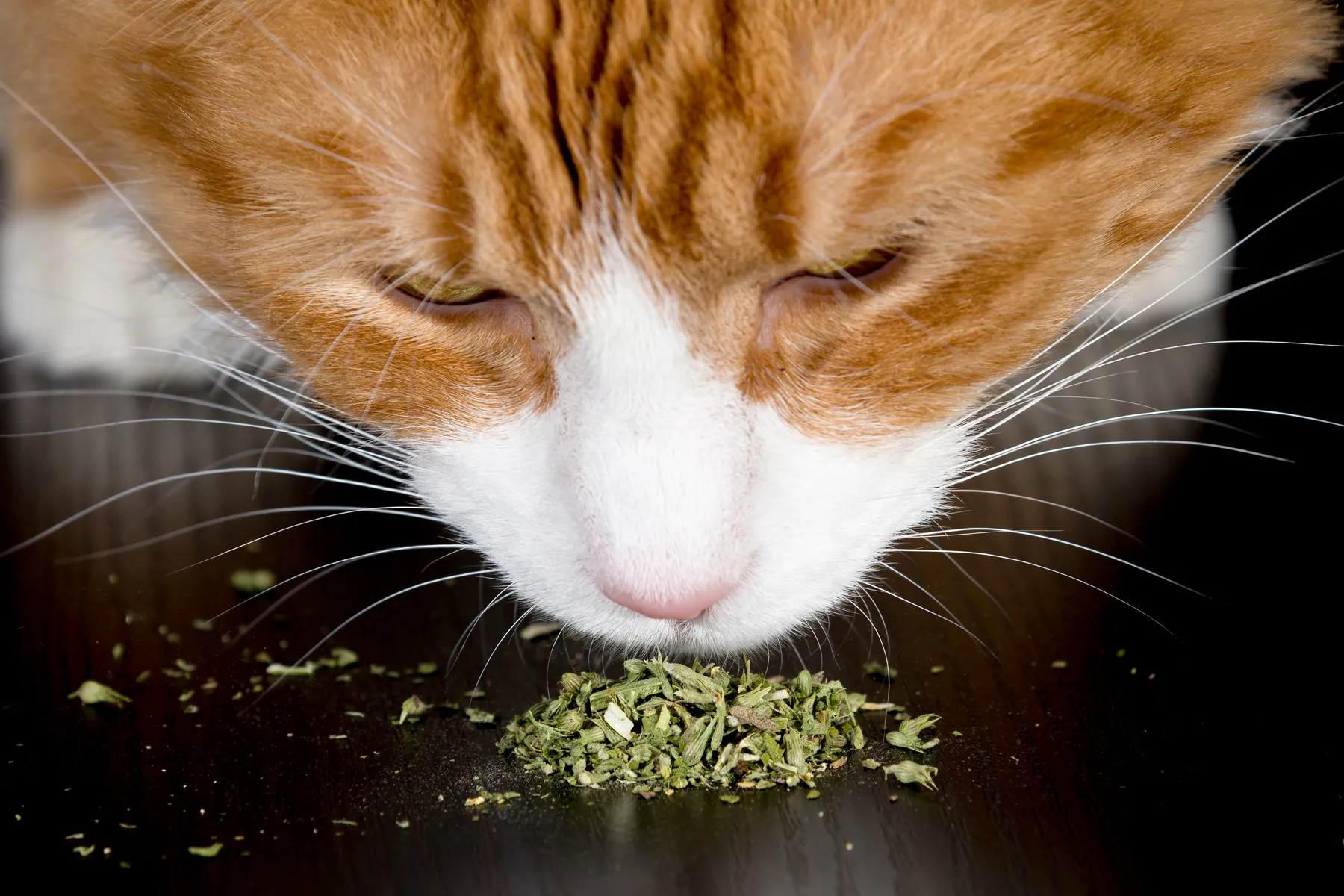Can You Put Catnip in Cat Food? If you have a cat, chances are you’ve considered putting Catnip in their food.
After all, cats love Catnip, so it stands to reason that they would also love it in their food.
However, before you go ahead and add Catnip to your kitty’s meal, there are a few things you should know.
Table of Contents
Can You Put Catnip in Cat Food?
Yes, you can. But you must be careful about what kind of Catnip is for your cat.
Though it may seem like a simple task, there are a few potential side effects if the wrong type of Catnip is mixed into your pet’s food.
Our veterinarian has some helpful tips on ensuring this doesn’t happen.
- Purchase catnip from a pet store or online retailer.
- Place the Catnip in a dry, airtight container.
- Add the desired amount of Catnip to your cat’s food bowl.
- Start with a small amount and increase as needed.
- Monitor your cat’s reaction to the Catnip and adjust accordingly.

Credit: pets.webmd.com
Can I Mix Catnip With Wet Cat Food?
Yes, you can mix Catnip with wet cat food. Many people find their cats enjoy the taste of Catnip and often seek it out in their food.
However, it is important to remember that not all cats react to Catnip similarly.
Some may not be affected by it, while others may become playful or even aggressive when they eat it.
If you are unsure how your cat will react to Catnip, it is best to start with a small amount and see how they respond.
How Do You Feed A Cat Catnip?
If you want to give your cat a treat, there’s no need to look any further than their own backyard.
Catnip (Nepeta cataria) is a member of the mint family that naturally contains a chemical called nepetalactone.
This compound is irresistible to cats, which will roll around, chew on it, and even eat it in large quantities.
While most cats love Catnip, some may be indifferent or react negatively.
If your cat has never been exposed to Catnip before, start by giving them a small amount and observing their reaction.
If they seem interested, you can increase the amount next time.
There’s no need to worry about giving your cat too much Catnip – they will lose interest and walk away when they’ve had enough.
If you’re growing your own Catnip, keep an eye on it, as it can quickly take over a garden bed!
Snip them off at the stem, harvesting fresh leaves rather than pulling up the entire plant.
What Happens When a Cat Eats Catnip?
Most cats love Catnip and will roll around, chew on it, and rub their faces in it.
Some cats may even eat large amounts of fresh catnip leaves. Eating Catnip can cause your cat to become very playful or frisky.
Some cats may experience a mild euphoria similar to that caused by marijuana.
Other effects include drooling, head shaking, chin and cheek rubbing, meowing, purring, rolling, running about wildly, and leaping into the air.
The effects of Catnip usually last for about 10-15 minutes before wearing off.
Some cats may be more sensitive to Catnip than others. Kittens and older cats are less likely to react to Catnip than adult cats.
How Much Catnip Can Cats Eat?
Like most cat owners, you probably have a stash of Catnip somewhere in your home.
And if you’ve ever wondered how much Catnip your feline friend can actually eat, you’re not alone.
While it’s perfectly safe for cats to consume small amounts of Catnip, eating too much of the plant can cause gastrointestinal upset.
Signs that your cat has eaten too much Catnip include vomiting, diarrhea, and lethargy.
If you notice any of these signs, it’s best to contact your veterinarian immediately.
So How Much Catnip Is Too Much?
It really depends on the size of your cat. A good rule of thumb is to give them no more than 1 teaspoon per day.
If they seem to tolerate this amount well, you can slowly increase it over time.
Just be sure to monitor them closely for any adverse effects. And what if your kitty can’t get enough of that delicious Catnip? Well, you can do a few things to help limit their intake.
One is to purchase toys filled with Catnip and allow them to play with these instead of giving them the plant directly.
You can also try growing Catnip in a pot indoors so they can nibble on it at their leisure (make sure the pot is out of reach, so they don’t accidentally ingest too much).
Can you Mix Catnip with Cat Food?
How Much Catnip Should I Give My Cat?
You’re not alone if you’re wondering how much Catnip to give your cat. It’s a common question with a bit of a complicated answer.
The amount of Catnip you give your feline friend depends on a few factors, including age, size, and overall health.
For most healthy adult cats, a pinch or two of dried Catnip is plenty. If you have a kitten or an older cat who is less active, start with just a small sprinkle. You can always add more if needed.
And if your kitty seems particularly sensitive to Catnip, go easy at first and gradually increase the amount over time.
When it comes to fresh Catnip, less is more. A single leaf or sprig is all that’s needed for most cats.
If you have a very large or rambunctious kitty, you may be able to get away with giving them two leaves. But more than that is likely too much for even the most dedicated CatNip fiend!
A little bit of Catnip now and then is perfectly fine for our feline friends, but be sure to keep an eye on them if they consume large quantities at once.
What Does Catnip Do To Cats?
If you’ve wondered exactly what Catnip does to your feline friend, you’re not alone.
Many people are curious about this herb and its effects on cats. Catnip (Nepeta cataria) is a member of the mint family and is related to other herbs, such as basil, oregano, and sage.
The plant is native to Europe and Asia but can now be found worldwide.
Catnip contains a chemical called nepetalactone that attracts and affects cats.
When a cat smells Catnip, the nepetalactone binds to receptors in the cat’s nose.
This causes the neurons in the brain to fire off signals that result in a behaviour change.
Most cats will become more playful when they smell Catnip. Some may roll around on the ground or run back and forth.
Others may become more aggressive. Cats’ reaction to Catnip is similar to how humans react to drugs like LSD or marijuana – it’s a hallucinogen.
The effects of Catnip usually only last for 10-15 minutes before wearing off completely.
However, some cats may be affected for up to two hours after exposure.
Not all cats react to Catnip in the same way. Some cats don’t react at all!
It’s believed that sensitivity to Catnip is genetic and passed down from generation to generation.
If your kitty doesn’t seem interested in Catnip, there’s no need to worry – it just means they didn’t inherit the gene that allows them to experience its effects.
Can Cats Eat Dried Catnip?
Most cats love Catnip, and it’s perfectly safe for them to eat.
Many people give their cats a small amount of dried Catnip. If your cat enjoys eating Catnip, there’s no need to worry.
Just keep an eye on how much she eats, as too much can cause an upset stomach.
Do Cats Have To Eat Catnip To Get High?
Most cats love Catnip and will happily roll around, chew on it, and generally have a great time. But do they have to eat it to get high?
It turns out that while eating Catnip is certainly one way for cats to enjoy its effects, simply smelling the herb can also be enough to get them excited.
Some researchers believe that the smell of Catnip may be even more potent for cats than the actual ingestion of it.
So why do cats react so strongly to Catnip? It all has to do with a chemical compound called nepetalactone.
This substance is found in the plant’s leaves and flowers and acts as a natural feline attractant.
When a cat inhales nepetalactone, it binds to receptors in its nose, which causes them to experience a range of pleasurable sensations. Interestingly, not all cats respond to Catnip in the same way.
Some seem unaffected by it, while others go wild! There’s also evidence that kittens are more likely to enjoy its effects than adult cats.
So if your kitty isn’t into Catnip, don’t worry – there’s nothing wrong with them.
Conclusion
While Catnip is safe for cats to consume, there are a few things to remember if you consider adding it to your cat’s food.
First, a small amount goes a long way – too much Catnip can cause an upset stomach.
Second, some cats may not react to Catnip at all, so it’s best to introduce it gradually to see how your cat responds.
Lastly, fresh or dried Catnip is more potent than the powdered form, so start with a little and increase as needed.
If you have any questions about giving your cat nip, be sure to ask your veterinarian.

Hi there! My name is Koushik; I am a cat lover. I specialize in writing about pet care & food. I have a wealth of knowledge on cat food niches and related subjects. I have worked in the pet industry for over 5 years and am passionate about helping cat owners provide the best care for their furry friends. With knowledge of cat food and nutrition, I aim to share their insights and help cat owners navigate the world of cat food niches. I enjoy playing with my two cats, reading, and exploring new cat food brands in my free time.